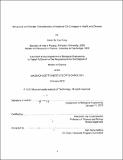Behavioral and genetic characteristics of intestinal cell lineages in health and disease
Author(s)
Kung, Kevin Su Yau
DownloadFull printable version (31.42Mb)
Other Contributors
Massachusetts Institute of Technology. Department of Biological Engineering.
Advisor
Alexander van Oudenaarden and Scott Manalis.
Terms of use
Metadata
Show full item recordAbstract
The intestinal crypt is a highly dynamic system, as the entire epithelium is constantly turned over and renewed by the proliferative stem cells located at the bottom of the crypt. While this system is crucial for nutrient absorption, any derangements in the proliferative cells can quickly lead to cancer. In this thesis, we sought to better understand the behavioral and genetic characteristics of the different cell types along the intestinal crypt, in a mouse model. We first attempted to quantify the migration velocities and proliferative rates at a single-cell level using 5-ethynol-2'-deoxyuridine (EdU) pulse-chase labeling. While we observed marked differences in the proliferation rates between the absorptive and secretory lineages (the former is faster), our experimental setup was unable to resolve any possible differences in migratory behaviors. We then turned our attention to quantifying the spatial expression patterns of selected transcripts in the intestinal crypt, both in wildtype and in an inducible APC-loss cancer model. We were able to show that the transcript expression profiles of key differentiation and proliferation markers (Creb313, Gob5, Ki-67, cMyc), as well as the ephrin signaling (EphB2 and EphrinBl) were significantly altered in the early stages (7 days) of adenoma formation. A more detailed analysis also separated this derangement in terms of extrinsic factors (e.g. altered cell composition along the crypt) and intrinsic factors (e.g. inherent change of cellular expression profile after APC loss). What is particularly interesting is that even differentiated cells in adenomas can exhibit such derangements. Our hypothesis to explain this observation is that these differentiated cells actually come from transformed stem cells. To test this hypothesis, we needed to verify that these cells indeed have excision at the Apc locus. After several approaches involving both single-molecule fluorescent in situ hybridization and quantitative polymerase chain reaction (PCR), the results were ultimately inconclusive. However, we propose several additional approaches that this hypothesis can be verified, and if verified, some biologically significant questions that can be addressed regarding the early dynamics of stem cells in intestinal cancer development.
Description
Thesis (S.M.)--Massachusetts Institute of Technology, Dept. of Biological Engineering, 2013. Cataloged from PDF version of thesis. Includes bibliographical references (p. 68-76).
Date issued
2013Department
Massachusetts Institute of Technology. Department of Biological EngineeringPublisher
Massachusetts Institute of Technology
Keywords
Biological Engineering.